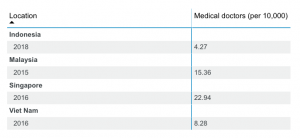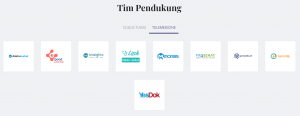More than a month after the first cases in the country were acknowledged, Indonesia is still struggling to contain the coronavirus outbreak. Meanwhile, health tech startups are providing more services for the public and taking part in the government’s responses to the pandemic.
When the outbreak was still in its early stage, many people in Indonesia turned to health tech apps for information about COVID-19, creating an uptick in traffic for these sites and apps. And as COVID-19 took root in the country, government bodies folded them into COVID-19 prevention campaigns.
Service providers such as Halodoc, Alodokter, and GrabHealth—Grab’s health service arm in collaboration with Good Doctor Technology Indonesia—have been appointed by Indonesia’s official COVID-19 task force to conduct preliminary screenings and lower the number of hospital visits.
“During the pandemic, it is important for the public not to rush to hospitals, especially for mild and non-emergency cases,” said Good Doctor Technology managing director Danu Wicaksana to KrASIA. “[It’s] not only to reduce the risk of infections at the medical facility, but then so medical facilities can relocate their resources to handle those with more severe status, which requires intense handling as their capacity is limited.”
The fourth most populous country in the world is, indeed, lacking in medical facilities and manpower. According to the World Health Organization (WHO), Indonesia only has 12 hospital beds and four medical doctors per 10,000 people in the country.

The ratio is far below the WHO-prescribed number of at least ten doctors and 50 beds for every 10,000 people.

As of May 3, the country has more than 11,000 positive cases, with 845 deaths and 1,876 recoveries. However, what concerns citizens the most are the number of patients under supervision (PDPs)—23,130 in all—because they have acute coronavirus symptoms, as well as the 236,369 people under monitoring (ODPs), because they exhibit mild symptoms and might have been in contact with patients who have already tested positive for COVID-19.
Assisting people in self-isolation and non-emergencies
While PDPs are eligible for treatment at government-appointed reference hospitals, ODPs are advised to self-isolate for two weeks and will only receive treatment if their condition worsens. This is where health tech apps come in handy.
“We did receive consultation requests from those who are self-isolating,” Wicaksana said. In handling users under self-isolation, the platform is following the Ministry of Health’s guidelines, which include physical distancing principles with other people who are in the same household, the use of health equipment such as face masks, and periodical online check-ups at least once every two days.
If a user’s symptoms become more serious, GrabHealth’s doctors will make recommendations to immediately seek assistance at a healthcare facility.
Halodoc, one of Indonesia’s largest health tech firms, applies similar policies for ODPs during teleconsultations. “These guidelines have been adjusted to the patient’s symptoms, including periodic health checks and drug delivery if needed,” said the firm’s CEO, Jonathan Sudharta.

This move was encouraged by government officials. The Indonesian COVID-19 task force has links to nine telehealth services on their official site.
“This is really good for patients who are self-isolating, in that they can continue communication and receive direction through these startups,” minister of health Terawan Agus Putranto told the Indonesian parliament in early April, as reported by Reuters.
The platforms also provide services for non-emergency cases to reduce hospital visits at this critical time. GrabHealth and Halodoc have a 24-hour free consultation service with its doctor-partners, as well as drug delivery services from the apps’ partner pharmacies. Sudharta observed that more users are using these features, especially after the government encouraged physical distancing and imposed a partial lockdown in several cities.
And a smaller player, AI-based diagnosis platform Prixa, was tapped by the Office of the Presidential Staff to log results from self-screening procedures prompted by the 10 Rumah Aman (“10 Safe Houses”) app.
Founded back in 2019, Prixa claimed they landed the role by bringing a “solution of scalable accessibility to healthcare” to the table. The platform analyzes a user’s symptoms using answers they entered into the app, then provides information about the ailment that may be the cause.
“Our engine is based on evidence-based medicine, in which our team of doctors digest published research, utilize the results, and combine them with guidelines set by the WHO and MoH to make a comprehensive tool to assess symptoms and risk,” Prixa’s CEO James Roring told KrASIA.
Read this: Indonesians skeptical of the state’s COVID-19 prevention apps
Flexibility for doctors on duty
Indonesia’s health workers face tough conditions as they work to manage and contain the outbreak. They lack proper protective equipment and are physically drained. The Indonesian Medical Association (IDI) confirmed that 25 of their members have died. Some of the casualties contracted the disease while treating patients, while others may have died from exhaustion.
GrabHealth confirmed that some of its doctor-partners are working double shifts by being on duty in hospitals and then conducting teleconsultations. To avoid overworking them, the platform is making adjustments. “Some of our doctor-partners who are still having duty in hospitals are given flexibility to adjust their consultation hours within GrabHealth in this difficult time,” said Wicaksana.
Read this: Indonesian health tech apps see surge in downloads due to COVID-19
Halodoc, on the other hand, has put more doctors online. Right now, the platform appoints at least 1,000 doctors for COVID-19-related consultations. This way, the workload can be distributed among more people, easing the stress on each doctor.
Various platforms are assisting medical professionals and other essential workers. GrabHealth is conducting free rapid tests and PCR tests for healthcare workers and Grab driver-partners in nine cities. They aim to provide free COVID-19 tests to 5,000 people until mid-May. And Halodoc, in cooperation with IDI and other institutions, distributed 2,000 sets of PPE, 2,000 full-face shields, and 100 portable sinks to several hospitals and public health centers in Jakarta.
New opportunities and shifting habits
The unprecedented public health crisis the world faces right now has prompted speedy adoption of digital services in the healthcare sector. According to executive insights by Galen Growth Asia, there will be a paradigm shift in the healthcare ecosystem in terms of how stakeholders apply digital tools.
In Indonesia, the number of people using health tech apps continues to soar. Halodoc noted more than 6 million users accessing its app’s COVID-19 self-screening feature since March, while its user count has tripled. GrabHealth also had to increase its capacity fourfold to match demand.
“We realize that everyone is facing a very challenging time. People’s movement is limited in the midst of this pandemic,” said Sudharta. “Technology has an important role as a bridge for the community’s needs, including the needs of health services and medicines.”
With many Indonesians utilizing telemedicine services for the first time, there’s a good chance that they will continue to use these platforms in the future whenever the need arises. Good Doctor’s Wicaksana believes that many people will continue to take advantage of the convenience and efficiency offered by his firm. “This momentum will definitely change the way people seek medical help, with a more ‘online first’ mindset. If they feel mild complaints, they might turn to telemedicine first before going to visit a hospital,” he said.
GrabHealth and Good Doctor both recognize telemedicine as a trend that may become standard in the future, and the companies will ramp up their services to meet the needs of Indonesians, especially those who find it difficult to reach health facilities. However, this doesn’t mean telemedicine will replace offline doctor consultations. The two entities complement each other in preliminary patient care.
Meanwhile, smaller players gain exposure by collaborating with government institutions. “Prixa does get branding benefits, albeit it is not our primary motive,” Roring said.
Even before the pandemic, Indonesia’s digital health sector has attracted large amounts of investments. According to Galen Growth Asia, Indonesian and Singaporean platforms received approximately 93% of the USD 226 million in healthcare investments for the region. Halodoc and Alodokter bagged two mega-deals that amounted to USD 145 million together.
After the dust settles, it may not be surprising to find the next Indonesian unicorn in the health tech sector.

